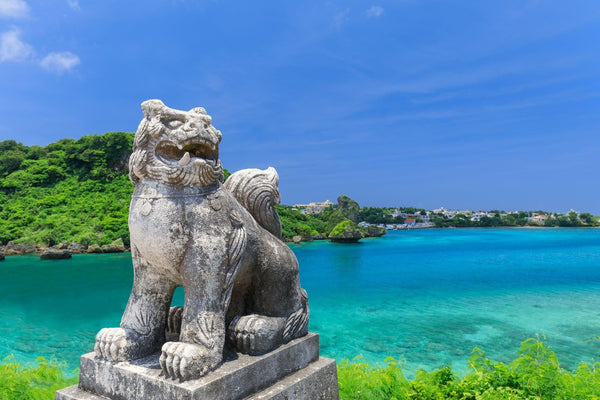A Guide To Shisa – The Guardians Of Okinawa

Jump to:
When wandering around Japanese souvenir stores, you may have seen a cute(?) - looking souvenir of a strange-looking creature that is designed to ward off evil spirits. You may also have noticed the presence of the same creature on statues outside, or on the roofs of, Japanese houses and businesses, particularly in Okinawa. These are Shisa, creatures from Ryukyu mythology that stretch far back into Okinawa’s history. Despite possessing a fearsome set of gnashers, these fanged beasts are actually considered to be friendly and comforting and are there to protect humans.
In this post, we will look at what Shisa are, the history and legends surrounding Shisa, the different types, how to position Shisa, and look at some popular Shisa statues that can be found around Okinawa, rounding up by looking at what options you may have for purchasing them.
What Are Shisa?

The word Shisa comes from the word “獅子”(pronounced “Shishi” and meaning “lion”) and these half-lion/half-dog gargoyle-like creatures and usually, although not always, found in male and female pairs. Traditionally, the female Shisa is close-mouthed, for keeping the good spirits in, whereas the male Shisa is open-mouthed to scare away evil spirits. Once you become aware of them when traveling around Okinawa, you will see them almost everywhere. Almost every Okinawan home will have a pair of Shisa at their entrance, and you will also find them in office buildings, stores, and schools. If you look carefully, you can even find Shisa-shaped roadblocks and construction barriers, and their image painted on manhole covers.
The History Of The Shisa
When looking for the origins of Shisa, we can go way back to 6000 BC when countries such as Egypt and India sculpted statues of lions as a demonstration of strength. Such statues made their way to China via the Silk Road creating a tradition of Chinese guardian lions. Due to the strong trading links between the Okinawan Ryukyu kingdom and China at the time, it is thought that one of these Chinese guardian lions was probably brought over to Okinawa as a gift in the 14th Century. They also bear similarities to the Komainu, which were also brought to Japan around that time. One major difference is that the Komainu are dedicated to protecting shrines and temples.
As it was believed that Shisa (which means “guardian of the house” or “amulet” in the Okinawan dialect) had magical powers to protect the owner of a property, the property itself, and the surrounding area, it is no surprise that they were placed in front of places of importance, such as temples, castle gates, royal monuments, village entrances, and other places with red-tiled roofs.
These red-tiled roofs played a significant role in delaying the spread of the popularity of the Shisa among common people and were affected by two main laws. The first was that it was only permitted to place Shisa on tiled roofs and not thatched ones. Another prevented commoners from owning tiled roofs. When this was repealed in the 19th century, it allowed ordinary Okinawans to have red tiled roofs where they could place Shisa, and this led to a great increase in their prevalence.
Legends Of Shisa

There are many legends surrounding Shisa. One such legend surrounds what is thought to be the oldest existing Shisa, which is in the southeast of Okinawa island. One such legend surrounds what is thought to be the oldest existing Shisa, which is in the southeast of Okinawa Island. In the village of Tomimori, near a town called Kochinda, people there suffered from frequent fires. The locals consulted with a Feng Shui master called Saiozui and questioned him on why they had so many fires. Saiozui believed that the frequent fires were due to the power of nearby Mt. Yaese and recommended that the townspeople build a stone Shisa facing Mt. Yaese. Legend has it that the town has been protected from fires ever since.
Another legend is that a Chinese envoy visited Shuri-jo castle and brought a gift for the Ryukyuan king consisting of a necklace adorned with a Shisa dog figurine. The king was rather taken with the figurine and decided to wear it under his clothes. In the bay near the port of Naha, the village of Madanbashi was frequently the target of a Sea Dragon that ate the villagers and destroyed their property. One day, when the king was visiting the village, one such attack happened and all the villagers ran away to hide. One day, when the king was visiting the village, one such attack happened, and all the villagers ran away to hide. The local mystic was instructed in a dream to ask the king during his visit to stand on the beach and raise his figurine in the direction of the dragon. He faced the monster with his raised figurine, and immediately the Shisa let out a gigantic roar, so deep and loud that it even shook the dragon and rang through the whole village, and this caused a huge stone to fall from the sky and crush the dragon's tail. The dragon could no longer move and finally died.
Different Types Of Shisa

You may be familiar with what a Shisa looks like, but you may not know that they come in a variety of different types. Shisa can be divided into three main categories, namely “Palace Shisa”, “Village Shisa”, and “House Shisa”.
The palace variety (or Miyajishi) was established between the 13th and 15th century and are the stone Shisa placed at Shuri-Jo castle in Naha as well as other castles in Okinawa. These Shisa are always set up in pairs. They were created more as a demonstration of authority than as an amulet for warding off evil.
The village variety (or Sonrakushishi) followed in 1689 and, also made of stone, they were set up at the entrances to villages. Unlike the Miyajishi, they come singly rather than in pairs, and their meaning differs as well, considered to be a guardian deity to protect the village from fire and calamity. There are currently 147 such Shisa (also called “stone lions) in Okinawa.
The House Shisa is the most common type of Shisa and is found in most homes as well as being a common sight in souvenir shops.
How Should Shisa Be Positioned?
As mentioned before, Shisa usually come in male and female pairs and the way that they are placed is important, with the open-mouthed male on the left and the closed-mouthed female on the right as seen when standing behind them and looking out from the property that it is guarding. According to Feng Sui theory placing a male and female pair brings luck and prosperity to the home. Additionally, this follows the Buddhist principle of “阿吽”(pronounced “A-un”), meaning the “beginning and the end” and involving an open- and closed-mouth pair.
Popular Shisa Statues In Okinawa?

You can find Shisa almost everywhere in Okinawa but there are several Shisa statues that stand out, either due to their mere size or their historical significance.
At the tip of Cape Zanpa which is located approximately 35 kilometers north of the capital Naha, there is a tall white lighthouse and a famous fishing area. The entrance to the Zanpa Misaki Recreation Plaza is protected by a huge red Shisa, measuring 8.75 meters in height.
Another spot worth seeing is the Shishiki-no-To monument that stands at the entrance to Okinawa World, located approximately 10 kilometers south of Naha. The monument contains five Shisa pointing in different directions, with the middle Shisa having been crafted by the famous potter Mitsuo Arakaki.
The Saion Ufa Shisa is located next to the Makishi Monorail station. This Shisa statue is made out of Tsuboya pottery, the most famous pottery type in Okinawa that uses enamels and clays unique to Okinawa. The statue is said to weigh around three tons, and at 3.4 meters tall it makes a striking impression on visitors using the monorail.
Where Can I Buy Shisa?
There is a wide range of options for buying Shisa, depending on your budget and available space in which to display it. If you are just looking for a cheap and cheerful souvenir in the shape of a Shisa, there are a whole host of souvenir shops in Okinawa that sell Shisa-related items, and if you leave it until the last minute, you can even pick one up at the airport.
There are also several options if you are looking for something more lasting and authentic. The Tsuboya Yachimun Street in downtown Naha is a great place to find a wide range of different Shisa. You can find a whole host of different sizes of Shisa, ranging from small souvenirs below 1,000 yen up to red clay hand-crafted 50cm-high statues going for around 300,000 yen for a pair.
The Yomitan pottery village, located just north of the Kadena air base, is smaller than the Tsuboya Yachimun street but also has a great range of Shisa statues. There are around 45 practicing potters in the village and their exquisite Shisa may set you back over half a million yen for a pair. Don’t worry if you are not quite ready to lash out such a huge sum on a guardian statue though, as similarly to Tsuboya Yachimun, there is something for every budget.
Shisa – The Half-Lion, Half-Dog Guardians Of Okinawa

If you do any research on Shisa, you will find out discover that there is a serious debate about what they actually are. Some people insist they are lions, while others are equally adamant that they are dogs. As is often the case, the truth probably lies somewhere in the middle and they are a mixture between the two. As is often the case, the truth probably lies somewhere in the middle, and they are a mixture between the two.
Whatever they are, there is no doubting the prevalence of Shisa in Okinawa, so much so that, since 2002, there has even been a special day of the year to celebrate them. In Japanese, the number four is often pronounced “Shi” and three is “San”, and as a result, April 3rd is the day of Shisa in Okinawa.
Shisa come in a wide range of sizes and prices from huge stone statues to cheap and cheerful souvenirs, so why not add buy a traditional Japanese Shisa for a property you consider worth protecting?
Want to learn more about Okinawan culture? Check out this article about Okinawan cuisine.

0 comments